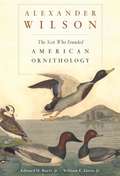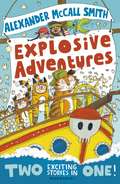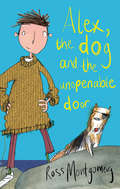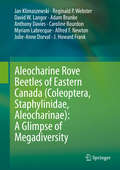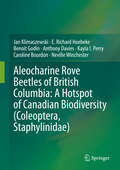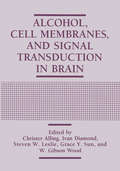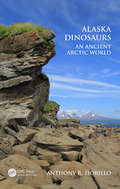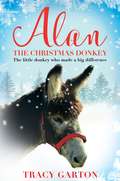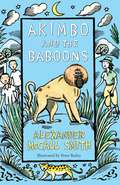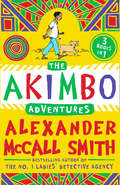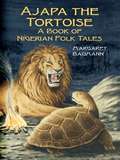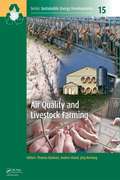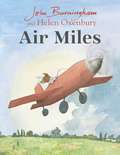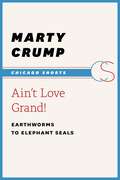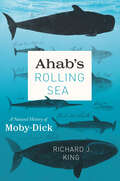- Table View
- List View
Alexander Wilson: The Scot Who Founded American Ornithology
by Edward H. Burtt Jr.On the bicentennial of his death, this beautifully illustrated volume pays tribute to the Scot who became the father of American ornithology. Alexander Wilson made unique contributions to ecology and animal behavior. His drawings of birds in realistic poses in their natural habitat inspired Audubon, Spencer Fullerton Baird, and other naturalists.
Alexander Wilson: The Scot Who Founded American Ornithology
by Edward H. Burtt Jr.On the bicentennial of his death, this beautifully illustrated volume pays tribute to the Scot who became the father of American ornithology. Alexander Wilson made unique contributions to ecology and animal behavior. His drawings of birds in realistic poses in their natural habitat inspired Audubon, Spencer Fullerton Baird, and other naturalists.
Alexander McCall Smith's Explosive Adventures
by Alexander McCall SmithAn irresistible bind-up edition of two fabulously fun, wonderfully witty adventure mysteries, from the bestselling author of the No.1 Ladies' Detective Agency series, Alexander McCall Smith, and with amazing illustrations by Kate Hindley throughout. Popcorn PiratesThe greediest gang of grub-guzzling pirates ever to sail the high seas is after the Popcorn Islands' harvest. Can Lucy, Hermione and Sam stop them? The Bubblegum TreeThe secret ingredient for Gopal's Best Pink Bubblegum has not been delivered for two months. Billy, Nicola and Mr Gopal are off to the jungle in a flying boat to solve the baffling mystery ...
Alex, the Dog and the Unopenable Door
by Ross MontgomeryAlex Jennings is a boy with a problem.His mum's sent him away to boarding school because his father, the most famously failed explorer in the history of the Cusp, has escaped from hospital again, yelling 'squiggles'.Make that two problems.Now the evil Davidus Kyte and all his henchmen are after Alex, convinced he alone knows the meaning of the word 'squiggles'.OK, make that three - Alex Jennings is a boy with a lot of problems. But with the help of a talking dog and a girl with unfeasibly sharp teeth, he just might have what it takes to cross the Forbidden Lands, escape the evil Davidus Kyte, and find out what lies beyond the Cusp . . .
Aleocharine Rove Beetles of Eastern Canada (Coleoptera, Staphylinidae, Aleocharinae): A Glimpse of Megadiversity
by Jan Klimaszewski Reginald P. Webster David W. Langor Adam Brunke Anthony Davies Caroline Bourdon Myriam Labrecque Alfred F. Newton Julie-Anne Dorval J. Howard FrankA first comprehensive synopsis of all aleocharine rove beetle species (Coleoptera, Staphylinidae) recorded from eastern Canada, from Ontario to the Maritime Provinces inclusively, is presented. Four hundred and seven species in 96 genera, and 16 tribes are presented and discussed.Tribes and subtribes are arranged in presumably phylogenetic order as it is currently recognized. Genera and subgenera are listed alphabetically. Species are listed alphabetically or in species groups to better reflect their relationships. Species distribution is listed by abbreviated provinces and territories in Canada and abbreviated states in the United States. Geographic status is given to every species as Native, Holarctic or adventive with some species listed with undetermined status - adventive or Holarctic. Every treated species is presented with a diagnosis, including short description of body and description of the median lobe of aedeagus, spermatheca, and tergite and sternite VIII of both sexes. For each species a plate with colour habitus image and black and white images of genital structures is provided to aid with positive identification. Collection and habitat data (often new) are presented for each species, including data on macrohabitat, microhabitat, collecting period, and collecting methods.
Aleocharine Rove Beetles of British Columbia: A Hotspot of Canadian Biodiversity (Coleoptera, Staphylinidae)
by Jan Klimaszewski E. Richard Hoebeke Benoit Godin Anthony Davies Kayla I. Perry Caroline Bourdon Neville WinchesterAleocharine beetles are among the most poorly known and difficult-to-identify groups of Coleoptera worldwide. This book presents the first comprehensive synopsis of aleocharine rove beetle species (Coleoptera, Staphylinidae) from British Columbia, Canada. It is important to generate a structured inventory of species in hotspots of biodiversity like British Columbia, to provide baseline biodiversity data for monitoring species responses related to climate change. It is the first book to treat and illustrate every recorded and new species. For every species, color illustrations are provided, including color habitus and genital diagnostic structures of both sexes. Two hundred and twenty-seven valid species, including 14 new species, 16 new generic records, and 36 (excluding new species) new provincial and 6 state records, in 79 genera and 14 tribes.Tribes and subtribes are arranged in phylogenetic order as it is currently recognized, and genera and subgenera are listed alphabetically within each tribe or subtribe. Species are listed alphabetically or in species groups to better reflect their relationships. Species distribution is listed by provinces and territories in Canada and states in the United States, and the geographic origin of each species is categorized as native, Holarctic, adventive or undetermined (either adventive or Holarctic). Every species is presented with a morphological diagnosis including external and genital characters of both sexes. Collection and habitat data are presented for each species, including collecting period, and collecting methods. A list of all Canadian species with their currently known distribution in North America is presented at the end of the book.
Alcoholism: A Molecular Perspective (Nato Science Series A: #206)
by T. Norman PalmerThis book contains selected proceedings from the NATO Advanced Study Institute (AS I) "The Molecular Pathology of Alcoholism" held at the Hotel Il Ciocco in Tuscany during 26th August - 6th September 1990. Alcoholism remains one of the most challenging problems in medical care, with far-reaching medical, social and economic consequences. For example in the U. S. , estimates indicate that 18 million people have a serious drinking problem and that the total cost to the economy of alcohol abuse is $117 billion. Treatment of alcohol dependence and other alcohol-related disorders accounts for almost 15% of the total health bill of the United States. Despite the scale of the medical problem, biomedical research on alcoholism remains something of a 'Cinderella science'. Research funding from government and other bodies is relatively poor and the number of medical scientists working in the field remains small. The Organizing Committee for this NATO ASI, comprising Charles Lieber (New York), Timothy Peters (London), Mario Dianzani (Torino), Emanuele Albano (Torino) and Norman Palmer (perth, Director), were therefore particularly grateful to the NATO Scientific Affairs Division for their active support of this AS I, the first dealing with a topic related to alcohol abuse. We moreover hope that this support will continue. The theme of the ASI was an in depth discussion of the molecular events initiated by alcohol abuse that culminate in onset of alcohol-related disease.
Alcohol, Cell Membranes, and Signal Transduction in Brain
by Christer Alling Ivan Diamond Steven W. Leslie Grace Y. Sun W. Gibson WoodAlcohol abuse and alcoholism are international problems whose costs economical ly, psychologically and medically have been well documented. Alcohol is a unique drug in that the effects of excessive use can have a deleterious effect on most if not all organs of the body. The brain is one of the organs most affected by excessive alcohol consumption. Effects on the brain can be seen in cognitive function, brain structure and neurochemistry. Over the past few years, there have been significant advances made in understanding how alcohol affects brain neurochemistry. This book examines four major areas, i. e. , membrane lipids, receptors and ion channels, second messengers, and gene expression, where significant advancements have been made. The book is divided into four sections based on the four major areas. In each section, data are examined that cover a range of approaches from in vitro to in vivo studies. The section on membrane lipids includes recent developments in how ethanol affects membrane cholesterol domains, polyunsaturated fatty acids, the cause and consequences of phosphatidylethanol formation, and the modulation of membrane protein function by lipid-protein interaction. The second section comprises chapters on NMDA and 5-HT3 receptors, including new aspects on alcohol neurotoxicity and the molecular heterogeneity that may underlie differences in alcohol sensitivity as well as chapters on GABA-gated chloride flux, and calcium channels.
Albatrosses, Petrels and Shearwaters of the World (Princeton Field Guides)
by Derek Onley Paul ScofieldFamous for their size and elegance in flight, albatrosses are familiar to anyone who has travelled through the southern oceans, and are a flagship family of conservation concern. However, albatrosses are just one of several groups of 'pelagic' birds - those that visit land only to breed, and spend the rest of their lives far from the coast, soaring from ocean to ocean in a never-ending search for food. Mysterious and graceful, these birds can present a formidable identification challenge to even the most experienced birder. This fixed-format ebook provides the answer - the first comprehensive guide to pelagic birds, the albatrosses, petrels, shearwaters, storm-petrels and diving petrels. Optimised for iPad, it features the book in crisp, clear high-resolution. A total of 46 detailed, fully zoomable colour plates highlight key ID criteria of the birds in flight, with close-ups of diagnostic regions of the plumage. The plates are accompanied by accurate distribution maps, while the sparkling text brings the world of these amazing birds to life.Sea-watchers all around the world will find this superb field guide indispensable – and no birder will want to be without it.
Albatrosses, Petrels and Shearwaters of the World (Helm Field Guides)
by Derek Onley Paul ScofieldFamous for their size and elegance in flight, albatrosses are familiar to anyone who has travelled through the southern oceans, and are a flagship family of conservation concern. However, albatrosses are just one of several groups of 'pelagic' birds - those that visit land only to breed, and spend the rest of their lives far from the coast, soaring from ocean to ocean in a never-ending search for food. Mysterious and graceful, these birds can present a formidable identification challenge to even the most experienced birder. This book provides the answer - the first comprehensive guide to pelagic birds, the albatrosses, petrels, shearwaters, storm-petrels and diving petrels. A total of 46 spectacular colour plates highlight key ID criteria of the birds in flight, with close-ups of diagnostic regions of the plumage. The plates are accompanied by accurate distribution maps, while the sparkling text brings the world of these amazing birds to life. Several extremely rare species, such as Beck's Petrel, are illustrated for the first time, while the New Zealand Storm-petrel, rediscovered as recently as 2004, is also included.Sea-watchers all around the world will find this superb field guide indispensable.
Alaska Dinosaurs: An Ancient Arctic World
by Anthony R. FiorilloAnthony Fiorillo has been exploring the Arctic since 1998. For him, like many others, the Arctic holds the romance of uncharted territory, extreme conditions, and the inevitable epic challenges that arise. For Fiorillo, however, the Arctic also holds the secrets of the history of life on Earth, and its fossils bring him back field season after field season in pursuit of improving human understanding of ancient history. His studies of the rocks and fossils of the Arctic shed light on a world that once was, and provide insight into what might be.
Alaska Dinosaurs: An Ancient Arctic World
by Anthony R. FiorilloAnthony Fiorillo has been exploring the Arctic since 1998. For him, like many others, the Arctic holds the romance of uncharted territory, extreme conditions, and the inevitable epic challenges that arise. For Fiorillo, however, the Arctic also holds the secrets of the history of life on Earth, and its fossils bring him back field season after field season in pursuit of improving human understanding of ancient history. His studies of the rocks and fossils of the Arctic shed light on a world that once was, and provide insight into what might be.
Alan The Christmas Donkey: The little donkey who made a big difference
by Tracy GartonThe true story of a loveable rescue donkey who becomes a hero, perfect for animal lovers everywhere.Tracy Garton had run the Radcliffe Donkey Sanctuary for twenty years, creating a safe haven for more than sixty sick, unwanted and mistreated donkeys. But after a devastatingly difficult winter, with sky high bills, she didn't know if she could afford to carry on - or if she had the physical strength to keep going. Then, in the first week of January, the phone rang. A donkey had been abandoned 130 miles away. Rushing to his rescue Tracy found Alan - forlorn, balding and shivering - tethered up tightly in a supermarket car park. Barely able to walk on his painfully overgrown hooves, he had been left to die. Tracy ran her hands gently over Alan's protruding ribs, and whispered in his ear: 'Don't worry boy, I won't give up on you.' Over the next twelve months, as Tracy grappled with attacks from vandals and perilous flash floods and desperately tried to raise money, Alan gradually recovered - turning into a loveable rogue. As Christmas rolled around, Tracy was too worried about the future to enjoy the festive season. She had no idea that the shy skinny animal she'd rescued was going to give her the greatest gift of all . . . Alan The Christmas Donkey is a funny, warm and inspiring read.
Akimbo And The Baboons (PDF)
by Alexander McCall Smith Peter BaileyIncludes brilliant baboon facts! Akimbo loves his life in Africa and the animals that live there. In this newest Akimbo story, a lady comes to study the baboons in the game reserve where Akimbo's father is the head ranger. Akimbo is keen to help and find out all he can about baboons - and in so doing comes closer to a much more dangerous animal
The Akimbo Adventures (Akimbo)
by Alexander McCall SmithThree classic adventure tales from the bestselling author of The No. 1 Ladies’ Detective Agency, now together in paperback for the first time. Imagine living in the heart of Africa. Imagine living in a place where the sun rises every morning over blue mountains.
Ajapa the Tortoise: A Book of Nigerian Folk Tales
by Margaret BaumannLong before people could turn to books for instruction and amusement, they relied upon storytellers for answers to their questions about life. Africa boasts a particularly rich oral tradition, in which the griot -- village historian -- preserved and passed along cultural beliefs and experiences from one generation to the next. This collection of 30 timeless fables comes from the storytellers of Nigeria, whose memorable narratives tell of promises kept and broken, virtue rewarded, and treachery punished.Ajapa the Tortoise -- a trickster, or animal with human qualities -- makes frequent appearances among the colorful cast of talking animals. In "Tortoise Goes Wooing," he learns a valuable lesson in friendship and sharing. Ajapa's further adventures describe how, among other things, he became a chief, acquired all of the world's wisdom, saved the king, tricked the lion, and came to be bald. Recounted in simple but evocative language, these ancient tales continue to enchant readers and listeners of all ages.
Airway Smooth Muscle in Health and Disease
by R. F. CoburnI organized this book because there is a need to put together in book form recent advances in our knowledge of how airway smooth muscle:works in health and in disease. After a period when it seemed that progress was very slow, there has been in the past few years an incredibly rapid gathering of knowledge in this area. In particular, our understanding has improved regarding the cascades of events that follow the initial binding of agonist to plasma membrane receptors and that lead to the cross-bridge movements that determine contraction. This advance in our knowledge was stimulated by use of single-and whole-cell channel recordings of plasma membrane currents and by description of the l3-receptor-GTP-binding protein-adenylate cyclase-cAMP coupling system, which serves as a model for other coupling mechanisms. The discovery of the receptor-activated inositol phospholipid transduction system has greatly stimulated research and led to advances in our understanding of mechanisms involved in smooth muscle con traction. Major advances were also triggered by the development of indicators for measuring free cytosolic calcium concentration and starting the unraveling of 2 the events involved in Ca + -dependent activation of contractile proteins. Al though most of the studies that led to our current understanding of these areas were performed on nonairway smooth muscle, these studies usually add to our understanding of airway smooth muscle, and there is an enlarging body of data that have been obtained on airway smooth muscle.
Air Quality and Livestock Farming (Sustainable Energy Developments)
by Thomas Banhazi Andres Aland Jörg HartungAir quality has a direct influence on health, welfare and production performance of livestock as the high concentrations of noxious gases, dust and airborne microorganisms are likely to reduce production efficiency and the general welfare of farm animals. Long term exposure to particulates in livestock buildings might also affect the respiratory health of farm workers. Dust in animal buildings contains many biologically active substances such as bacteria, fungi, endotoxins and residues of antibiotics (as a result of veterinary treatments) that are suspected to be hazardous to human health. Furthermore, air pollutants emitted from livestock buildings can reduce air, water and soil quality and can potentially undermine the health of nearby residents. Airborne emissions include ammonia, methane, nitrous oxide, particulates like dust and microorganisms. In addition, other potentially harmful substances such as heavy metals, antibiotic residues and components of disinfectants might be also emitted from livestock building that are potentially damaging to ecosystems. In this book, key aspects of agricultural air quality, such as monitoring, managing and reducing airborne pollutants in and around livestock facilities are reviewed. Features: addressing the raising awareness of the importance of optimal health and welfare for lifestock species with contributions from international specialists and researchers providing up-to-date information for professionals involved in modern animal producti This book will be useful for farming professionals, academics, students, policy makers, business leaders, regulatory bodies and agricultural consultants.
Air Quality and Livestock Farming (Sustainable Energy Developments)
by Thomas Banhazi Andres Aland Jörg HartungAir quality has a direct influence on health, welfare and production performance of livestock as the high concentrations of noxious gases, dust and airborne microorganisms are likely to reduce production efficiency and the general welfare of farm animals. Long term exposure to particulates in livestock buildings might also affect the respiratory health of farm workers. Dust in animal buildings contains many biologically active substances such as bacteria, fungi, endotoxins and residues of antibiotics (as a result of veterinary treatments) that are suspected to be hazardous to human health. Furthermore, air pollutants emitted from livestock buildings can reduce air, water and soil quality and can potentially undermine the health of nearby residents. Airborne emissions include ammonia, methane, nitrous oxide, particulates like dust and microorganisms. In addition, other potentially harmful substances such as heavy metals, antibiotic residues and components of disinfectants might be also emitted from livestock building that are potentially damaging to ecosystems. In this book, key aspects of agricultural air quality, such as monitoring, managing and reducing airborne pollutants in and around livestock facilities are reviewed. Features: addressing the raising awareness of the importance of optimal health and welfare for lifestock species with contributions from international specialists and researchers providing up-to-date information for professionals involved in modern animal producti This book will be useful for farming professionals, academics, students, policy makers, business leaders, regulatory bodies and agricultural consultants.
Air Miles
by John Burningham Bill SalamanA poignant book about new horizons and saying goodbye from best-loved creators: John Burningham and Helen OxenburyMiles is a difficult dog who loves to ride in his motor car. He's growing older, but a new challenge awaits when he takes to the skies.A picture book of beauty, infinite possibility, and love, which explores loss and grief in subtle and comforting ways.This is the award-winning author-illustrator John Burningham's last story - written by friend, Bill Salaman and illustrated by Helen Oxenbury.
Ain't Love Grand!: Earthworms to Elephant Seals (Chicago Shorts)
by Marty CrumpThe natural world is filled with diverse—not to mention quirky and odd—animal behaviors. Consider the male praying mantis that continues to mate after being beheaded; the insects, insects, and birds that offer gifts of food in return for sex; the male hip-pocket frog that carries his own tadpoles; the baby spiders that dine on their mother; or the starfish that sheds an arm or two to escape a predator's grasp. In Ain’t Love Grand, Marty Crump—a tropical field biologist well known for her work with the reproductive behavior of amphibians—examines the bizarre conduct of animals as they mate, parent, feed, defend themselves, and communicate. More importantly, Crump points out that diverse and unrelated animals often share seemingly erratic behaviors—evidence, Crump argues, that these natural histories, though outwardly weird, are actually successful ways of living.
Ahab's Rolling Sea: A Natural History of "Moby-Dick"
by Richard J. KingAlthough Herman Melville’s Moby-Dick is beloved as one of the most profound and enduring works of American fiction, we rarely consider it a work of nature writing—or even a novel of the sea. Yet Pulitzer Prize–winning author Annie Dillard avers Moby-Dick is the “best book ever written about nature,” and nearly the entirety of the story is set on the waves, with scarcely a whiff of land. In fact, Ishmael’s sea yarn is in conversation with the nature writing of Emerson and Thoreau, and Melville himself did much more than live for a year in a cabin beside a pond. He set sail: to the far remote Pacific Ocean, spending more than three years at sea before writing his masterpiece in 1851. A revelation for Moby-Dick devotees and neophytes alike, Ahab’s Rolling Sea is a chronological journey through the natural history of Melville’s novel. From white whales to whale intelligence, giant squids, barnacles, albatross, and sharks, Richard J. King examines what Melville knew from his own experiences and the sources available to a reader in the mid-1800s, exploring how and why Melville might have twisted what was known to serve his fiction. King then climbs to the crow’s nest, setting Melville in the context of the American perception of the ocean in 1851—at the very start of the Industrial Revolution and just before the publication of On the Origin of Species. King compares Ahab’s and Ishmael’s worldviews to how we see the ocean today: an expanse still immortal and sublime, but also in crisis. And although the concept of stewardship of the sea would have been entirely foreign, if not absurd, to Melville, King argues that Melville’s narrator Ishmael reveals his own tendencies toward what we would now call environmentalism. Featuring a coffer of illustrations and an array of interviews with contemporary scientists, fishers, and whale watch operators, Ahab’s Rolling Sea offers new insight not only into a cherished masterwork and its author but also into our evolving relationship with the briny deep—from whale hunters to climate refugees.
Ahab's Rolling Sea: A Natural History of "Moby-Dick"
by Richard J. KingAlthough Herman Melville’s Moby-Dick is beloved as one of the most profound and enduring works of American fiction, we rarely consider it a work of nature writing—or even a novel of the sea. Yet Pulitzer Prize–winning author Annie Dillard avers Moby-Dick is the “best book ever written about nature,” and nearly the entirety of the story is set on the waves, with scarcely a whiff of land. In fact, Ishmael’s sea yarn is in conversation with the nature writing of Emerson and Thoreau, and Melville himself did much more than live for a year in a cabin beside a pond. He set sail: to the far remote Pacific Ocean, spending more than three years at sea before writing his masterpiece in 1851. A revelation for Moby-Dick devotees and neophytes alike, Ahab’s Rolling Sea is a chronological journey through the natural history of Melville’s novel. From white whales to whale intelligence, giant squids, barnacles, albatross, and sharks, Richard J. King examines what Melville knew from his own experiences and the sources available to a reader in the mid-1800s, exploring how and why Melville might have twisted what was known to serve his fiction. King then climbs to the crow’s nest, setting Melville in the context of the American perception of the ocean in 1851—at the very start of the Industrial Revolution and just before the publication of On the Origin of Species. King compares Ahab’s and Ishmael’s worldviews to how we see the ocean today: an expanse still immortal and sublime, but also in crisis. And although the concept of stewardship of the sea would have been entirely foreign, if not absurd, to Melville, King argues that Melville’s narrator Ishmael reveals his own tendencies toward what we would now call environmentalism. Featuring a coffer of illustrations and an array of interviews with contemporary scientists, fishers, and whale watch operators, Ahab’s Rolling Sea offers new insight not only into a cherished masterwork and its author but also into our evolving relationship with the briny deep—from whale hunters to climate refugees.
Ahab's Rolling Sea: A Natural History of "Moby-Dick"
by Richard J. KingAlthough Herman Melville’s Moby-Dick is beloved as one of the most profound and enduring works of American fiction, we rarely consider it a work of nature writing—or even a novel of the sea. Yet Pulitzer Prize–winning author Annie Dillard avers Moby-Dick is the “best book ever written about nature,” and nearly the entirety of the story is set on the waves, with scarcely a whiff of land. In fact, Ishmael’s sea yarn is in conversation with the nature writing of Emerson and Thoreau, and Melville himself did much more than live for a year in a cabin beside a pond. He set sail: to the far remote Pacific Ocean, spending more than three years at sea before writing his masterpiece in 1851. A revelation for Moby-Dick devotees and neophytes alike, Ahab’s Rolling Sea is a chronological journey through the natural history of Melville’s novel. From white whales to whale intelligence, giant squids, barnacles, albatross, and sharks, Richard J. King examines what Melville knew from his own experiences and the sources available to a reader in the mid-1800s, exploring how and why Melville might have twisted what was known to serve his fiction. King then climbs to the crow’s nest, setting Melville in the context of the American perception of the ocean in 1851—at the very start of the Industrial Revolution and just before the publication of On the Origin of Species. King compares Ahab’s and Ishmael’s worldviews to how we see the ocean today: an expanse still immortal and sublime, but also in crisis. And although the concept of stewardship of the sea would have been entirely foreign, if not absurd, to Melville, King argues that Melville’s narrator Ishmael reveals his own tendencies toward what we would now call environmentalism. Featuring a coffer of illustrations and an array of interviews with contemporary scientists, fishers, and whale watch operators, Ahab’s Rolling Sea offers new insight not only into a cherished masterwork and its author but also into our evolving relationship with the briny deep—from whale hunters to climate refugees.
Ahab's Rolling Sea: A Natural History of "Moby-Dick"
by Richard J. KingAlthough Herman Melville’s Moby-Dick is beloved as one of the most profound and enduring works of American fiction, we rarely consider it a work of nature writing—or even a novel of the sea. Yet Pulitzer Prize–winning author Annie Dillard avers Moby-Dick is the “best book ever written about nature,” and nearly the entirety of the story is set on the waves, with scarcely a whiff of land. In fact, Ishmael’s sea yarn is in conversation with the nature writing of Emerson and Thoreau, and Melville himself did much more than live for a year in a cabin beside a pond. He set sail: to the far remote Pacific Ocean, spending more than three years at sea before writing his masterpiece in 1851. A revelation for Moby-Dick devotees and neophytes alike, Ahab’s Rolling Sea is a chronological journey through the natural history of Melville’s novel. From white whales to whale intelligence, giant squids, barnacles, albatross, and sharks, Richard J. King examines what Melville knew from his own experiences and the sources available to a reader in the mid-1800s, exploring how and why Melville might have twisted what was known to serve his fiction. King then climbs to the crow’s nest, setting Melville in the context of the American perception of the ocean in 1851—at the very start of the Industrial Revolution and just before the publication of On the Origin of Species. King compares Ahab’s and Ishmael’s worldviews to how we see the ocean today: an expanse still immortal and sublime, but also in crisis. And although the concept of stewardship of the sea would have been entirely foreign, if not absurd, to Melville, King argues that Melville’s narrator Ishmael reveals his own tendencies toward what we would now call environmentalism. Featuring a coffer of illustrations and an array of interviews with contemporary scientists, fishers, and whale watch operators, Ahab’s Rolling Sea offers new insight not only into a cherished masterwork and its author but also into our evolving relationship with the briny deep—from whale hunters to climate refugees.

